
Ceratosoma amoenum
(Cheeseman, 1886)
Order: NUDIBRANCHIA
Suborder: DORIDINA
Family: Chromodorididae
DISTRIBUTION
Temperate southern Australia and northern New Zealand.
PHOTO
UPPER RIGHT: Long Reef, Sydney, New South Wales, Oct 1986 (small orange and wine spots); Kurnell, Sydney, May 1987 (large orange spots). PHOTOS: Bill Rudman.
LOWER LEFT: Eden, southern New South Wales, Feb 1983. PHOTO: Bill Rudman.
LOWER RIGHT: Upper Photo - Port Phillip Bay, Victoria, Australia, March 1986. PHOTO: Bill Rudman. Lower Photo - Eagle Bay, Cape Naturaliste, southwestern Western Australia, sublittoral reef, April 1978. PHOTO: R. Kuiter.
Although in external shape this species looks much like a species of Hypselodoris its internal anatomy, especially the reproductive system and foregut anatomy show that its relationships lie with the genus Ceratosoma. Most species of Ceratosoma are characterised by a large recurved dorsal horn as in Ceratosoma alleni but it is absent in both the temperate water species in southern Australia, C. amoena and Ceratosoma brevicaudatum.
Ceratosoma amoenum also shows considerable colour variation through out its range. In Western Australia the orange spots are very small and numerous and the reddish purple spots form a submarginal band around the edge of the mantle. Moving east, the reddish purple spots become more numerous and widespread over the mantle and the orange spots become larger. In New Zealand the orange spots are very large and the purple markings are often absent.
Note added 4 July 2007: The name is changed today from C. amoena to C. amoenum - see message #20101.
-
Rudman, W.B. (1984) The Chromodorididae (Opisthobranchia: Mollusca) of the Indo-West Pacific: a review of the genera. Zoological Journal of the Linnean Society 81: 115-273.
-
Rudman, W.B. (1988) The Chromodorididae (Opisthobranchia: Mollusca) of the Indo-West Pacific: the genus Ceratosoma J.E. Gray. Zoological Journal of the Linnean Society 93(2): 133-185.
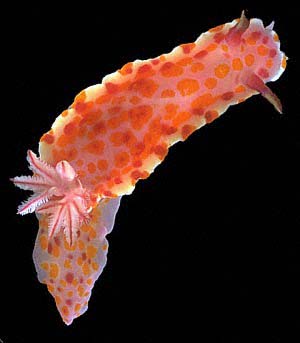
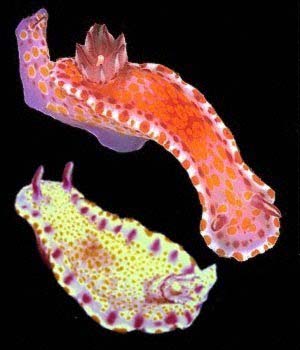
Rudman, W.B., 1998 (December 14) Ceratosoma amoenum (Cheeseman, 1886). [In] Sea Slug Forum. Australian Museum, Sydney. Available from http://www.seaslugforum.net/find/ceraamoe
Related messages
Ceratosoma amoenum from South Australia
April 12, 2010
From: Agnieszka Malkowska

Hello list,
My name is Aggie and I took a photo of this pair while diving on the wreck of Glenelg Dredge, South Australia, sometime in the past year. However I cannot find the common or scientific name of the nudibranch in any book I own.
Please assist with your vast knowledge in identifying these little guys.
Locality: Wreck of Glenelg Dredge, depth approx 20 meters, South Australia, Australia, [6 km west of Adelaide in St Vincent Gulf]. Length: Approx 2-3 cm. Photographer: Agnieszka Malkowska.
Thanks
Aggie Malkowska
scubaaggie@optusnet.com.au
Malkowska, A., 2010 (Apr 12) Ceratosoma amoenum from South Australia. [Message in] Sea Slug Forum. Australian Museum, Sydney. Available from http://www.seaslugforum.net/find/23465
Dear Agnieszka,
This a colour form of Ceratosoma amoenum apparently found only in southern Australia. While most species of Ceratasoma are found in tropical waters, this species is found in New Zealand, and southern Australia from New South Wales to Western Australia.
It is nice to get this photo because it shows the species on a species of Dysidea, which is one of the sponges it feeds on.
Best wishes,
Bill Rudman
Ceratosoma amoena 'doing things'
April 27, 2007
From: Samuel Kemp

Dear Bill
Here are some 'activity' photos of Ceratosoma amoena for you. What causes the bumps on the surface of these slugs - surely not the cold? In the upper photo, the 2 slugs appear to have devoured most of the sponge on which they are enjoying themselves.
Locality: Poor Knights and White Island, 5-25 m, New Zealand, Pacific Ocean, Jan-Feb 2007. Photo: Samuel Kemp.
Samuel Kemp
samuel_kemp@hotmail.com
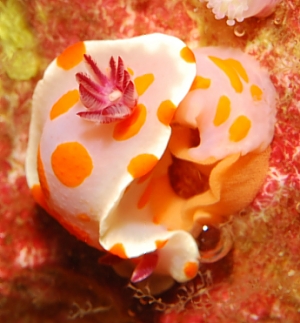
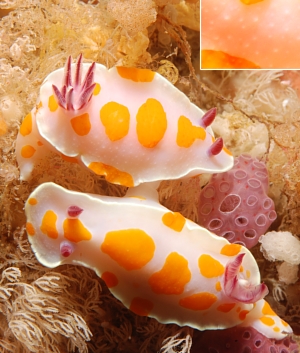
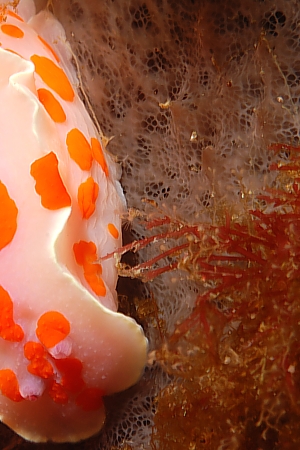
Thanks Sam,
Photos showing mating, egg laying and feeding in one message - it must be my lucky day! I have also added a close-up of your feeding photo alongside. In that photo, all that remains of the sponge they are eating is the network of fibres which form the skeleton in the group of sponges. As these sponges lack the mineral spicules found in the skeleton of most sponges, sponge taxonomists use the way these fibrous bundles are arranged to classify the families. Hopefully the arrangement is clear enough in your photos for me to get this sponge identified.
Concerning the bumps on the skin. A number of chromodorid species show this phenomenon to various degrees. Chromodorids, as well as having large mantle glands also have small glands scattered over the surface of the skin, and I think that's what these bumps are. As these animals have a fluid skeleton - they are a bit like a balloon filled with water - the skin in any one part of the body can vary in how stretched it is depending on what is happening elsewhere in the body. For example, during mating the mating apparatus has to be pushed out, and during feeding the oral tube is also pushed out so the fluid pressure in one part of the body can be lowered to allow for higher pressure elsewhere. At such times, the small glands are the only parts of the skin that can't change shape, so they stick out as small bumps.
Best wishes,
Bill Rudman
Ceratosoma amoena - more photos
April 27, 2007
From: Floor Anthoni

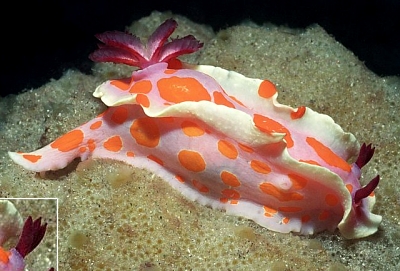
Dear Bill,
I have enclosed a few more photos of Ceratosoma amoena for your records. from Parengarenga Harbour in the far north of New Zealand
Some of these measured a whopping 10 cm [upper 2 photos], thriving in the rapidly degrading environment of the Parengarenga Harbour.
Kind regards,
Floor Anthoni
http://www.seafriends.org.nz/
floor[at]seafriends.org.nz

Thanks Floor,
It's good to get a wide coverage of New Zealand specimens so we have a better idea of colour variation. You may not have noticed, but in the second photo the animal has a trifid left rhinophore, which I can add to the abnormalities page. That animal also seems to be on one of the irciniid sponges which incorporate sand grains in their skeleton. However there is no indication to suggest the slug is feeding. I am not sure in the lower photo if either of the two animals are responsible for the egg mass, but I have seen this same orange egg ribbon on other of your photos and it matches that of C. amoena from eastern Australia.
Best wishes,
Bill Rudman
Ceratosoma amoena - mating aggregation
April 26, 2007
From: Floor Anthoni
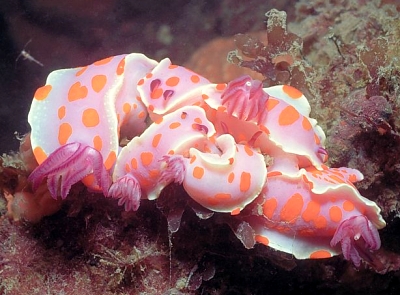
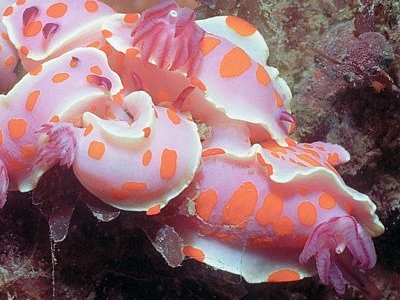
Hi Bill,
No sign of feeding here, but thought you might be interested.
Locality: Parengarenga Harbour, Northland, New Zealand. Harbour entrance at night. 5 Jan 2004. Photographer: Floor Anthoni
Best wishes,
Dr J Floor Anthoni
http://www.seafriends.org.nz/
floor[at]seafriends.org.nz

Dear Floor,
I suspect their food is nearby, but they certainly are more interested in each other than in eating at this moment.
When I reviewed the anatomy of this species many years ago, its reproductive system and gut were very similar to the tropical species of Ceratosoma, although it lacked the characteristic curved dorsal horn found in species such as Ceratosoma trilobatum. One other feature it had, which also linked it to Ceratosoma, was the concentration of large mantle glands at the rear of the mantle. These glands can't be seen in your photos, but in the close-up alongside you can see the small glands, it also has, scattered around the rest of the mantle edge as small white specks in the large animal on the left.
Best wishes,
Bill Rudman
Ceratosoma amoena - feeding aggregation
April 26, 2007
From: Dr J Floor Anthoni
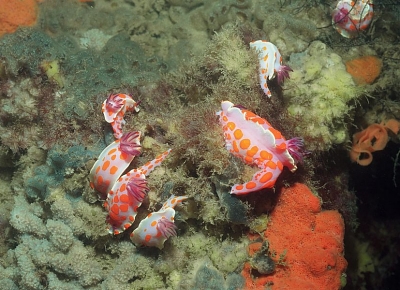
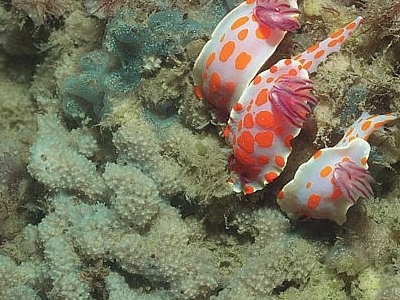
Dear Bill,
To help with your investigation into feeding, here are some photos of Ceratosoma amoena from northern New Zealand on sponges.
Locality: Paua Wharf, Parengarenga Harbour, Northland, New Zealand. 2 Jan 2004. Photographer: Floor Anthoni
Best wishes,
Floor Anthoni
http://www.seafriends.org.nz/
floor[at]seafriends.org.nz
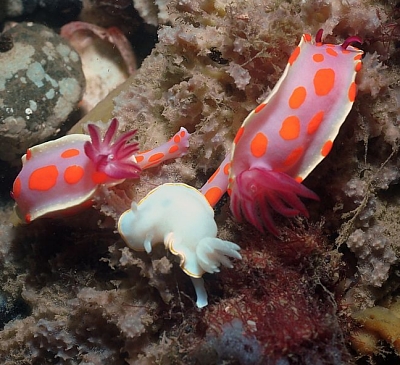
Dear Floor,
As I noted in your message concerning C. aureomarginata feeding [message #19840], I have been trying to confirm Michael C. Miller's record of this species and C. aureomarginata feeding on 'Dysidea fragilis' (see Miller, 1967). Up until now the only sponge I had records of C. amoena feeding on were of the thorectid genus Semitaspongia.
In both your photos in this message the Ceratosoma are showing a very definite interest in a species of Dysidea. Although we can see a pair mating in the top right corner of the upper photo, the rest of the animals seem to be much more interested in the sponge than they are in each other, which would suggest to me that they are feeding.
-
Miller, M. C. (1967) Grazing carnivores - some sea-slugs feeding on sedentary invertebrates. Poirieria (Conchology Section Auckland Institute & Museum), 3(1): 1-11.
Best wishes,
Bill Rudman
Ceratosoma amoena - feeding aggregation?
April 25, 2007
From: Ross Armstrong
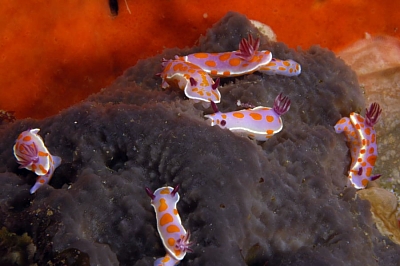

Dear Bill,
Following your email asking about records of Ceratosoma amoena feeding, here is a photo Diane took of a group of Ceratosoma amoena on a sponge at the Poor Knights. Not sure if they were feeding.
Poor Knights Islands, Northland, New Zealand. South Pacific Ocean. Photographer: Diane Armstrong
Best regards
Ross Armstrong
ross@oceanwildlife.com
Armstrong, R., 2007 (Apr 25) Ceratosoma amoena - feeding aggregation?. [Message in] Sea Slug Forum. Australian Museum, Sydney. Available from http://www.seaslugforum.net/find/19838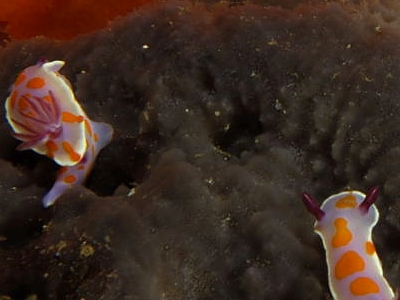
Dear Ross,
Thanks for this record. I am pretty sure this is a species of Semitaspongia which Prof. Bergquist has previously identified as this species' 'food' from both eastern Australia and northern New Zealand. Although there is no obvious sign of damage to the sponge, at least two of the animals seem to have their buccal bulbs extended. Also in this case and in others on the Forum [#9268, #9360] there are numbers of Ceratosoma on the sponge, but not mating, suggesting that they are attracted by the sponge and not necessarily by each other.
Best wishes,
Bill Rudman
Re: Hypselodoris bennetti & Ceratosoma amoena
April 11, 2007
From: Lynda Clarke
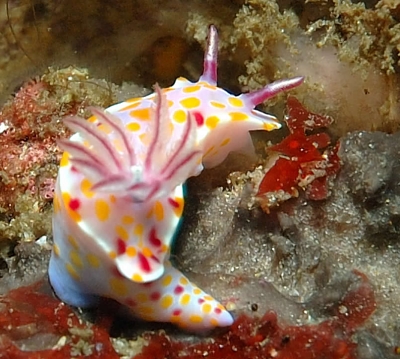
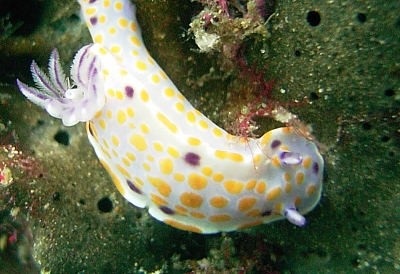
Concerning message #19437:
Dear Bill,
Sorry for the misunderstanding; Both species, Hypselodoris bennetti and Ceratosoma amoena are common at Julian Rocks, but only Hypselodoris bennetti shows a marked affinity for the grey sponges. Ceratosoma amoena is more usually found in the less exposed habitat shown in this photo.
Upper photo: Julian Rocks, nthn New South Wales, Nov 2005
Photographer Andrew Green.
Middle photo: Julian Rocks, nthn New South Wales, Nov 2006. Photographer Lynda Clarke.
Lower photo: Julian Rocks, nthn New South Wales, Nov 2006. Photographer John Natoli.
Lynda Clarke
polymath@bigpond.com
Clarke, L., 2007 (Apr 11) Re: Hypselodoris bennetti & Ceratosoma amoena. [Message in] Sea Slug Forum. Australian Museum, Sydney. Available from http://www.seaslugforum.net/find/19811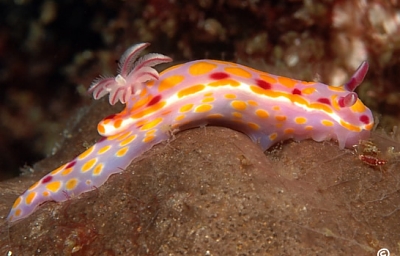
Dear Lynda,
Thanks very much for the clarification. The sponge in these three photos is almost certainly a thorectid sponge, probably a species of Semitaspongia, which is what we have seen it feeding on before.
Best wishes,
Bill Rudman
Re: Ceratosoma amoena from sthn Queensland
March 6, 2007
From: Rachel Murphy
Concerning message #17129:
Hi Bill
Last saturday, 3rd March, I was diving the wreck of St Paul, north of Moreton Island and found 4 Ceratosoma amoena. Unfortunately couldn't take photos as my camera is on the fritz. This wreck is 42 m deep, water temp on the bottom was 25C. I was using trimix, so am confident of my identification :-) It seems that this creature would be bucking the trend and heading north rather than the usual tropical finds in temperate zones. I have previously seen it at "China Wall" which is on the eastern side of Moreton island, north of the Rocks at Stradbroke island.
Locality: Wreck of the St Paul, 42 m, QLD, Australia, Pacific Ocean, 03 Mar 2007, wreck on sandy bottom. Length: ~2 cm
regards
Rachel
rmurphy@cicr.uq.edu.au
Murphy, R., 2007 (Mar 6) Re: Ceratosoma amoena from sthn Queensland. [Message in] Sea Slug Forum. Australian Museum, Sydney. Available from http://www.seaslugforum.net/find/19606Dear Rachel,
It is certainly interesting to find this species so far north, but Willan & Coleman, (1984) reported it from Nth Stradbroke Island, so its presence in southern Queensland is probably not a recent event. When you camera is back in action it would be good to get a photo or two of your population just to see what the colour pattern is so far north. And of course if you find it feeding it laying eggs that would be worth a few photos as well.
Best wishes,
Bill Rudman
Ceratosoma amoena from Bateman's Bay, New South Wales
January 9, 2007
From: Eileen Baker

Hi Bill,
We often see this nudibranch when looking in rockpools, but are not sure of its id. Any ideas about would be greatly appreciated.
Locality: Guerilla Bay, intertidal , Bateman's Bay, sthn NSW, Australia, Pacific Ocean, 21 December 2006, Intertidal. Length: 30 mm. Photographer: Eileen Baker.
Thanks,
Eileen
bakersla@bigpond.net.au
Baker, E.S., 2007 (Jan 9) Ceratosoma amoena from Bateman's Bay, New South Wales. [Message in] Sea Slug Forum. Australian Museum, Sydney. Available from http://www.seaslugforum.net/find/19072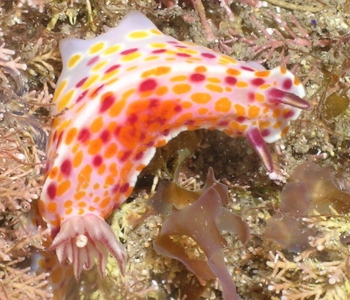
Dear Eileen,
This is Ceratosoma amoena, a colourful chromodorid nudibranch found in southern Australia and New Zealand
Best wishes,
Bill Rudman
Ceratosoma amoena from sthn Queensland
July 15, 2006
From: Bruce Wilkie
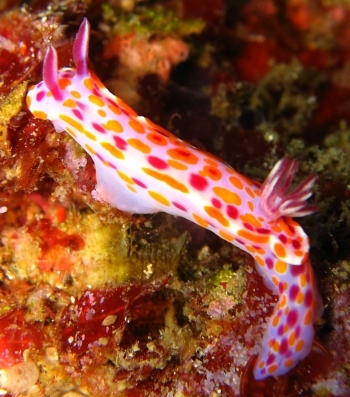
Hi Bill,
I was wanting to confirm the ID of this animal which I think is Ceratosoma amoena. It appears that it should be found a lot further south. I think it is an unusual find for southern Queensland.
Locality: Flat Rock North Stradbroke Island, 18mts, Queensland Australia, Pacific ocean, 13 July 2006, rocky reef with sponges, hard & soft corals . Length: 35mm. Photographer: Bruce Wilkie.
Many Thanks.
Bruce Wilkie.
brucedwilkie@yahoo.com.au
Wilkie,B, 2006 (Jul 15) Ceratosoma amoena from sthn Queensland. [Message in] Sea Slug Forum. Australian Museum, Sydney. Available from http://www.seaslugforum.net/find/17129
Dear Bruce,
It is unusual to find this species so far north. It has been recorded from sthn Queensland before, but from what I can find, North Stradbroke Island seems to be its northern limit.
Best wishes,
Bill Rudman
Ceratosoma amoena from Tasmania
July 6, 2005
From: John Silberberg
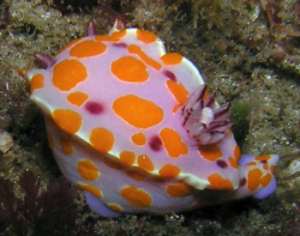
Is Ceratosoma amoena commonly found in Tasmanian waters?
I found one at 17 metres, 12 deg C, on a rocky reef. This was in the Governor Island Marine Reserve off Bicheno. I am confident of the ID as it matches pictures in Edgar's book and Coleman's 1001 Nudis. However, neither book categorically includes Tasmania in the distribution.
Locality: Governor Island Marine Reserve, Bicheno, Tasmania, Australia.
Depth: 17 metres. Length: 55 mm. 3 July 2005. Rocky Reef. Photographer: John Silberberg
Cheers
John.
john.silberberg@bigpond.com
Silberberg, J, 2005 (Jul 6) Ceratosoma amoena from Tasmania. [Message in] Sea Slug Forum. Australian Museum, Sydney. Available from http://www.seaslugforum.net/find/14194Dear John,
As I say on the Fact Sheet it is known from temperate southern Australia and northern New Zealand. I only have a few reords of it being found in Tasmania but that is more a reflection on the lack of collecting and opisthobranch research in Tasmania, than on the relative abundance of the nudibranchs. Any more photos and observations you have of Tasmanian opisthobranchs will be very welcome
Best wishes,
Bill Rudman
Ceratosoma amoena (?) laying eggs
April 11, 2005
From: Martina Fuchsberger

Dear Bill,
I also found this nudi laying eggs while diving in Melbourne over Easter. Its not the best pic, but unfortunately the only one I have from this particular nudibranch. I think it might be a Ceratosoma amoena. Can you please confirm this or let me know the correct ID.
Locality: J4 Submarine (27m Sub), Melbourne, Victoria, Australia. Depth: 27 m. 27 March 2005. on Wreck. Photographer: Martina Fuchsberger
Thanks a bunch,
Martina Fuchsberger
m.fuchsberger@gmx.at
Fuchsberger, M., 2005 (Apr 11) Ceratosoma amoena (?) laying eggs. [Message in] Sea Slug Forum. Australian Museum, Sydney. Available from http://www.seaslugforum.net/find/13471Dear Martina,
Yes this is a colour form of Ceratosoma amoena. Its useful to get this photo of an orange egg ribbon. Leanne & David Atkinson, in an earlier message [#9360] show that it can also be pink.
Best wishes,
Bill Rudman
Ceratosoma amoena from South Australia
January 26, 2005
From: Carl Mooney
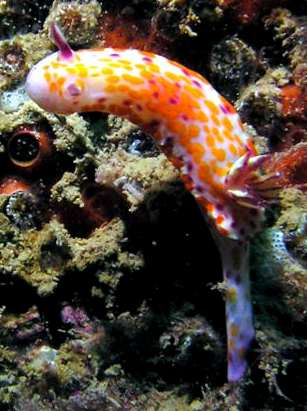
Hi,
I'm interested in identifying the nudibranchs attached
Locality: Port Noarlunga, South Australia, Gulf St Vincent
Depth: 20 metres. Length: 35-40 mm. 30 October 2004. on Wreck
Photographer: Carl Mooney
Regards,
Carl Mooney
selenite@bigpond.net.au
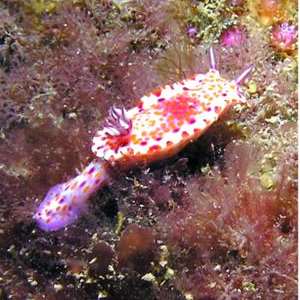

Dear Carl,
This is Ceratosoma amoena. Your animals show the typical colour form of this species at the middle of its range from New Zealand, across the Tasman Sea to eastern Australia and along the south coast of Australia to Western Australia. The orange spots are small and numerous and the small purple spots although mostly restricted to a submarginal band around the mantle, are sometimes scattered elsewhere.
Best wishes,
Bill Rudman
Ceratosoma amoena from New Zealand
February 6, 2004
From: Pam McAssey
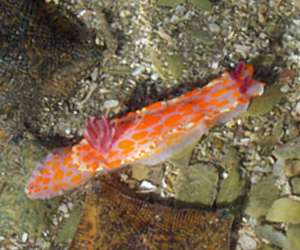
Found in a tide pool at low tide in Mount Maunganui, New Zealand. March 2003. I am hoping that someone could give me a name for this beautiful creature.
Thank you,
Pam Monroe,
New York
pmcassey@hotmail.com
McAssey, P., 2004 (Feb 6) Ceratosoma amoena from New Zealand. [Message in] Sea Slug Forum. Australian Museum, Sydney. Available from http://www.seaslugforum.net/find/12139Dear Pam,
This is Ceratosoma amoena which is found on both sides of the Tasman Sea. If you look through some of the other messages on this species, which are attached below yours on this page, you will see that New Zealand animals usually don't have any reddish spots, while those from southern Australia usually do, but the extent of red spotting varies around the coast
Best wishes
Bill Rudman
Ceratosoma amoena
February 1, 2004
From: Mathew McGuire
Dear Dr Rudman,
I just wanted to write in to thank you,and all the contributors to the Sea Slug Forum, on such a wonderful site. It has been an invaluable source of information for a recent project on "slugs" and last weekend helped me in identifying a beautiful little Ceratosoma amoena, that I discovered in a shallow rock pool in the intertidal zone at Toowoon Bay, NSW. It measured about 25mm long and it's colour so vivid that it caught my eye from about 5 metres away. Disimilar from the photos on your page in that it didn't have any spots in the middle of its back, only the red spots around the mantle. I only wish I had a camera to share the image with all.
Regards,
Mat
latanzi@hotmail.com
McGuire, M., 2004 (Feb 1) Ceratosoma amoena. [Message in] Sea Slug Forum. Australian Museum, Sydney. Available from http://www.seaslugforum.net/find/12050Dear Mat,
I'm glad you find the site useful. Ceratosoma amoena is one of those species which can now and then be found in shallow intertidal pools, although at this time of year the water in the pools tends to get a bit too warm on a sunny day
Best wishes
Bill Rudman
Colour variation in Ceratosoma amoena
January 21, 2004
From: Sean McMahon
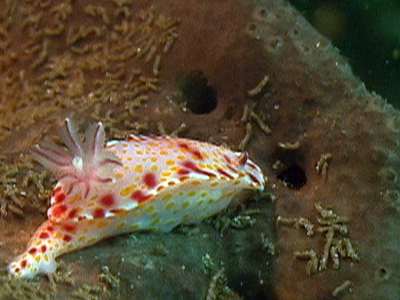

G'day,
I have come across a few nudibranchs on separate dives at Oak Park, Cronulla [Syney, NSW, Australia]. They appear to be Ceratosoma amoena. I have included photos of two separate individuals. I
Regards,
Sean.
16a@l52.navy.gov.au
McMahon, S., 2004 (Jan 21) Colour variation in Ceratosoma amoena. [Message in] Sea Slug Forum. Australian Museum, Sydney. Available from http://www.seaslugforum.net/find/11965
Dear Sean,
Yes these are a colour form of C. amoena. Have a look at the species Fact Sheet for some information on colour variation.
Youe photos are also quite helpful because they give us a bit more information on the sponge food of this species. As you can see in your photo alongside, the sponge it feeds on is often partially covered in other marine growths, so the slug appears to be just crawling over the bottom. In your upper photos however the sponge colony is relatively clean so it should be identifiable
Best wishes
Bill Rudman
Ceratosoma amoena feeding
December 24, 2003
From: David & Leanne Atkinson
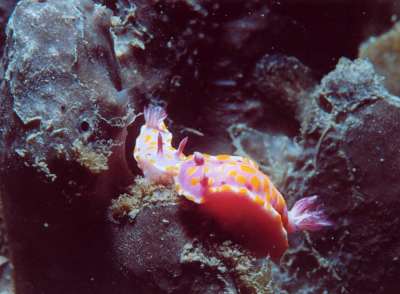
Dear Bill,
We recently photographed Ceratosoma amoena feeding on what, to the untrained eye, looks like the same grey sponge as the Chromodoris splendida in our previous message. You already have photos of Ceratosoma feeding on a grey sponge. Our photos show the mouth parts everted and we thought that may be of interest.
Date: 22 November 2003
Locality: Fly Point Marine Reserve, Port Stephens, NSW, Australia
Depth: 10m
Water Temperature: 16 degrees celcius
This sponge seems quite popular with all our common local nudibranchs.
Merry Christmas,
Leanne & David Atkinson
atk@hunterlink.net.au
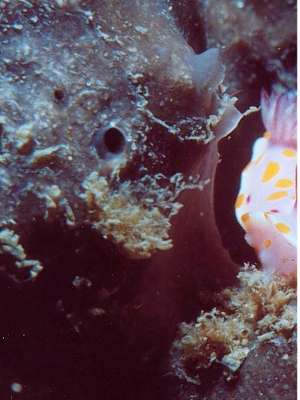
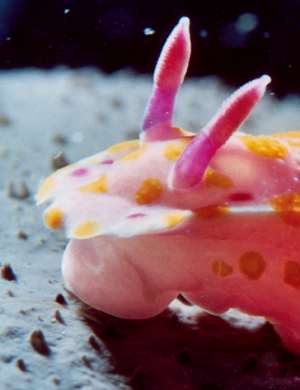
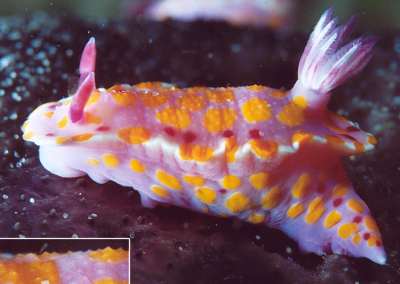
Dear David & Leanne,
This observation is a nice Christmas present. Hopefully I can get these identifications sorted out early in the new year. One problem with many sponges is that different colonies of the same sponge can be quite different in general shape and colour. Even different parts of the same colony can differ so it needs a trained eye to sort them out
Best wishes
Bill Rudman
Ceratosoma amoena - feeding
July 12, 2003
From: Sue Newson
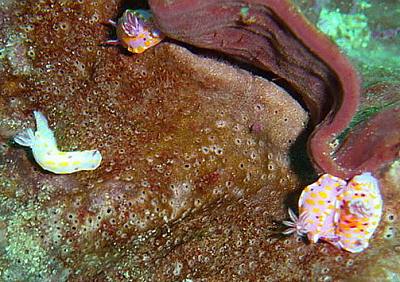
I found this photo of Ceratosoma amoena in my collection and thought it could be useful to you. It was taken at a site called Fish Rock in Jervis Bay, New South Wales, Australia, at a depth of 24m. If you look closely at the sponge? the nudibranch is on, you'll notice the change of colour and texture.
Sue Newson
snewson@shoal.net.au
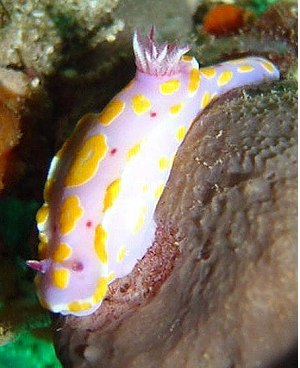

Thansk Sue,
Yes this is a very valuable record of Ceratosoma amoena feeding. I am pretty I recognise the sponge from the upper photo, and the lower photos definitely show the tell-tale sign of feeding. I will get the sponge identity checked by an expert.
best wishes,
Bill Rudman
Ceratosoma amoena laying eggs
June 13, 2003
From: Leanne & David Atkinson
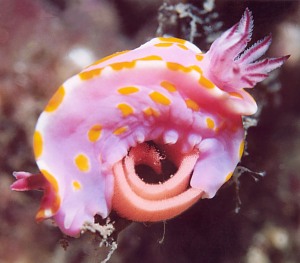

Dear Bill,
We know we've sent you a picture of Ceratosoma amoena laying eggs before [see message] but we've just taken this one which we think is better. You can see the nudi shaping the eggs into the rosette as it is laying. We thought you might be interested. It is a print and the image is not reversed, for those who are interested in the direction they are laid.
Location: Fly Point, Port Stephens, NSW Australia
Date: 24.05.03
Depth: 8m
Time: 4:15pm
Tide: High, 1.38m
Water Temp: 18 degrees celcius
Leanne & David Atkinson
atk@hunterlink.net.au
Atkinson, L. & D., 2003 (Jun 13) Ceratosoma amoena laying eggs. [Message in] Sea Slug Forum. Australian Museum, Sydney. Available from http://www.seaslugforum.net/find/10137Thanks Leanne & David,
It's always good to have more than one photo. Your earlier photo shows the egg ribbon has an outfolding at the top of the ribbon, which is not that obvious in your latest photo. Thanks also for checking the direction of coiling - its very easy to reverse negatives or transparencies when scanning.
Best wishes
Bill Rudman
Ceratosoma amoena laying eggs
March 11, 2003
From: Leanne & David Atkinson

Dear Bill,
I was just reading your latest messages and saw your request for a picture of Ceratosoma amoena laying eggs. We have this one. We also have a shot of them mating with gills out so I've included it. Both photos were taken at Fly Point marine reserve, Port Stephens N.S.W., eastern Australia, during daytime, on the high tide, at 10 to 12metres.
Cheers,
Leanne & David Atkinson
atk@hunterlink.net.au
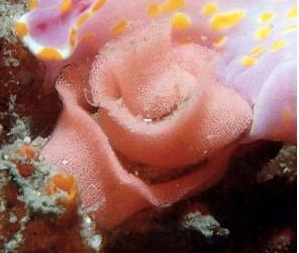
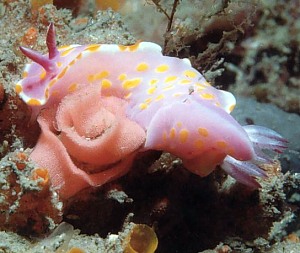
Dear Leanne & David,
Thanks very much. This photo of the egg ribbon is another valuable bit of information. If you compare the size of the eggs in this ribbon with those in your photo of the egg ribbon of Chromodoris splendida you will see C. splendida's eggs are quite a lot larger. Thompson (1972)reports that C. amoena has small eggs (90 microns in diameter), and planktotrophic larvae. Your egg ribbon is certainly compatible with that type of development.
• Thompson, T.E. (1972) Chromodorid nudibranchs from eastern Australia (Gastropoda, Opisthobranchia). Journal of Zoology, London, 166: 391-409,pls.1-4.
Best wishes,
Bill Rudman
Ceratosoma amoena on food sponge
February 23, 2003
From: Mark Burnett

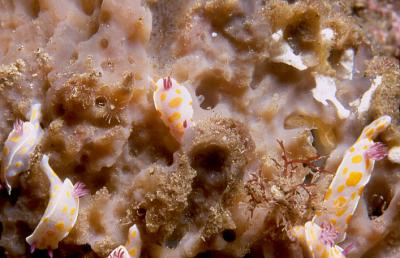
Hi Bill,
In reply to your request. Glad to oblige with a couple of slides of Ceratosoma amoena on its food sponge. These pictures were taken 15th February 2003 at the Poor Knights Ids -northeastern new Zealand]. The dive site was El Torito cave and the depth was 11 metres. The first slide has two adults of around 5cm, the second is of a sponge that seemed to have a whole family on a picnic. The smallest individuals were about 15mm and there were also bigger ones up to 3cm out of shot. I estimate there were 10 - 12 on this sponge. Within 5 metres of this sponge I also found Aphelodoris luctuosa, Dendrodoris denisoni and Tambja verconis. A good time of year at the Knights!
Regards
Mark Burnett
mburnett@actrix.gen.nz
Burnett, M., 2003 (Feb 23) Ceratosoma amoena on food sponge. [Message in] Sea Slug Forum. Australian Museum, Sydney. Available from http://www.seaslugforum.net/find/9268
Dear Mark,
Thanks for the very quick response. In an earlier message I noted that C. amoena had been reported feeding in New Zealand on a species of Dysidea. I suspect the sponge in both your photos are forms of the same species. I'll have to get its identity checked. Hopefully that can be done from the full size sections of your photos I have posted alongside
Cheers,
Bill Rudman
Ceratosoma amoena from New Zealand
February 21, 2003
From: Mark Burnett
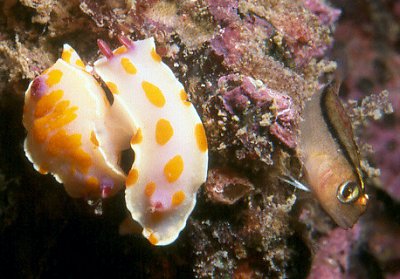
Hi Bill,
Diving a reef north of the Noises, Hauraki Gulf [northeastern New Zealand], I came across Ceratosoma amoena in large numbers. Admittedly it is a very common nudibranch here in New Zealand but there were literally hundreds of them, spread over the reef from 6 metres down to the sand at around 20 metres. Having quite a number of this species on slide already, I limited myself to a few pictures of a mating pair with attendant (?voyeuristic) triplefin. The pair were about 3cm long each and my strobe seemed to bother them enough to withdraw their gills.
Mark Burnett
mburnett@actrix.gen.nz
Burnett, M., 2003 (Feb 21) Ceratosoma amoena from New Zealand. [Message in] Sea Slug Forum. Australian Museum, Sydney. Available from http://www.seaslugforum.net/find/9213Thanks Mark,
The triplefin does seem to interested in the proceedings. I was interested in your mention of lots of photos of this species. If you have any photos of Ceratosoma egg-laying or actually feeding on a sponge it would be a valuable addition to the Forum
Best wishes,
Bill Rudman
Ceratosoma amoena from Lord Howe Island
January 8, 2003
From: W.B. Rudman
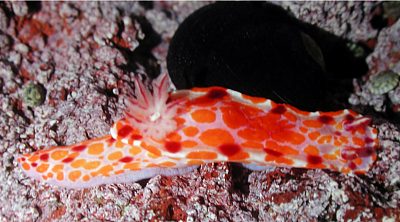
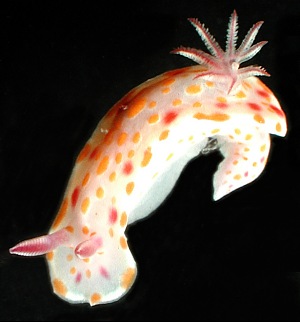
Here are two colour forms from Ian Hutton of Ceratosoma amoena from Lord Howe Island.
Location: Neds Beach.
Bill Rudman
Rudman, W.B., 2003 (Jan 8) Ceratosoma amoena from Lord Howe Island. [Message in] Sea Slug Forum. Australian Museum, Sydney. Available from http://www.seaslugforum.net/find/8823Ceratosoma amoena from Maroubra, Sydney
December 8, 2002
From: Chris Partridge
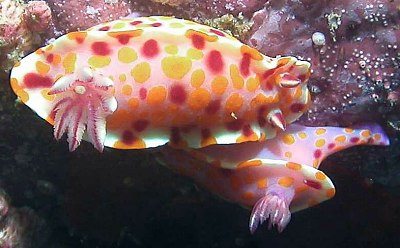
Whilst on a dive near Maroubra Beach I happened apon this little fellow and its friend ..... I have not seen this species before in and never in Sydney waters. Could you help identify it as I have been unable to find any resource that has this critter in it.
The location 16.3m south of Maroubra beach, Sydney, Australia. It was found on a rock shelf wall of about 1.5m. Water temp: 19 deg C., 23 November 2002.
Chris Partridge
cspart@bigpond.com
Partridge, C., 2002 (Dec 8) Ceratosoma amoena from Maroubra, Sydney. [Message in] Sea Slug Forum. Australian Museum, Sydney. Available from http://www.seaslugforum.net/find/8552Dear Chris,
This is a mating pair of Ceratosoma amoena - or if not mating, they appear to be getting prepared to.
Best wishes,
Bill Rudman
Ceratosoma amoena from Sydney, NSW
November 18, 2002
From: Allan Saben
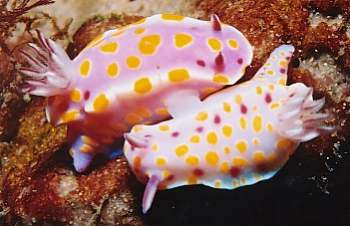
Dear Bill,
Here is a photo of Ceratosoma amoena mating.
Deewhy, Sydney, NSW [Australia]
Depth 29 meters
Macro 1:2
Many thanks
Allan
asaben@bigpond.net.au
Saben, A., 2002 (Nov 18) Ceratosoma amoena from Sydney, NSW. [Message in] Sea Slug Forum. Australian Museum, Sydney. Available from http://www.seaslugforum.net/find/8409Thanks Allan,
Bill Rudman
Ceratosoma amoena from sthn New South Wales
July 10, 2002
From: Tim McKenzie

Hope you can easily ID for this novice ... in 18 meters water southern NSW. About 2cm in length. Thought it may be Chromodoris tasmaniensis at first but my limited library and search have not come up with a good match. Your thoughts appreciated.
Tim McKenzie
tmckenzie@tmckenzie.com
McKenzie, T., 2002 (Jul 10) Ceratosoma amoena from sthn New South Wales. [Message in] Sea Slug Forum. Australian Museum, Sydney. Available from http://www.seaslugforum.net/find/7394Dear Tim,
This is Ceratosoma amoena. It's a bit pale in colour but quite unmistakeable. C. tasmaniensis can have spots of a similar orange colour, but it never has more than one colour, either orange or red, in its pattern.
Best wishes,
Bill Rudman
The food of Ceratosoma amoena
January 3, 2002
From: Craig Worthington
Hi Bill,
Just wondering ... I find numerous Ceratosoma amoena in northern New Zealand on both pink coralline 'paint' and coralline 'turf' algae. I'm aware that all Chromodorididae feed on specific sponges but do you think there is any chance that C. amoena may include coralline algae in its diet.
Thanks & Regards,
Craig Worthington.
craig.worthington@xtra.co.nz
Worthington, C., 2002 (Jan 3) The food of Ceratosoma amoena. [Message in] Sea Slug Forum. Australian Museum, Sydney. Available from http://www.seaslugforum.net/find/5889Dear Craig,
Morton & Miller (1968 - N.Z. Seashore) report C. amoena feeding on a species of the sponge genus Dysidea in New Zealand, but I don't know of any other reports. I am sure it doesn't feed on algae. Humans can choose to be purely herbivorous but that is because our gut is designed for both animal and vegetable food. Purely carnivorous animals, such as nudibranchs, have a gut that can only process animal matter so they would starve if fed plant material.
While many sponges form very visible structures on the sea floor, others grow as relatively thin layers over the bottom, and are often overgrown with algae and other fouling organisms. I suspect the sponge(s) that Ceratosoma amoena feeds on grow in this manner, so even when C. amoena is actually on its food sponge it appears to be just crawling over some algae. A common chromodorid in southeastern Australia, Hypselodoris bennetti, falls into this category. It is relatively common but the sponge it feeds on usually grows as a layer over the rocks. The chromodorid is only found on its sponge when the sponge forms a large bulky structure free of encrusting algae.
The other alternative is that its sponge food is only present as small scattered colonies, which would mean the slugs will need to do a bit of travelling between meals.
Best wishes,
Bill Rudman
Ceratosoma amoena from NSW, Australia
November 22, 2001
From: Stuart Hutchison
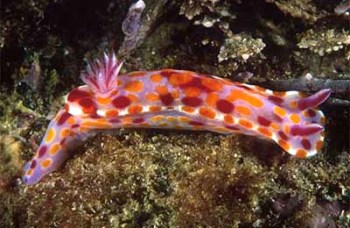
Hi Bill,
Here's a Ceratosoma amoena from Tathra, southern New South Wales, Australia in April 2000.
It's another of the potential red-spotted types you referred to earlier, although perhaps more identifiable. I thought this was a nice specimen.
It was about 50mm long at 7m depth.
Regards,
Stuart
stuart@stuarthutchison.com.au
Hutchison, S., 2001 (Nov 22) Ceratosoma amoena from NSW, Australia. [Message in] Sea Slug Forum. Australian Museum, Sydney. Available from http://www.seaslugforum.net/find/5685Thanks Stuart,
Bill Rudman
Chromodoris splendida? from New Zealand
October 5, 2001
From: Colin Gans
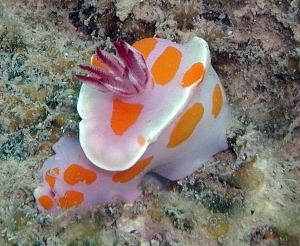
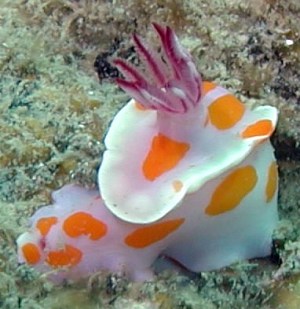
Hi
This one's from Auckland, New Zealand. I was out diving on Sunday off Waiheke Island and took this pic.[30 September 2001]
Can you confirm this as Chromodoris splendida?
Regards,
Colin Gans
colin@gans.co.nz
Gans, C., 2001 (Oct 5) Chromodoris splendida? from New Zealand. [Message in] Sea Slug Forum. Australian Museum, Sydney. Available from http://www.seaslugforum.net/find/5393Dear Colin,
Thanks for the photos. Your animal is Ceratosoma amoena which is found both in temperate Australia and New Zealand. There is some colour variation throughout its wide geographic range and in New Zealand all the specimens I know of have this pale pinkish-purple background colour, dark orange spots and purple gills & rhinophores. In your upper photo you can clearly see the opaque whitish patches around the posterior end of the mantle. These are the defensive mantle glands found in most species of chromodorid. Each genus has a particular general layout of these glands, and it appears that at least in some genera, like Hypselodoris, individual species can also be distinguished by the detailed placement and number of individual mantle glands.
Chromodoris splendida, to my knowledge, has not been recorded from New Zealand. It is basically a New South Wales species, although there have been a few reports from Victoria, in the south, and from as far north as Heron Island at the southern end of the Great Barrier Reef. In its usual colour form it is white with a yellow border and large bright red spots.
Any other photos of sea slugs from New Zealand are always welcome
Best wishes,
Bill Rudman
Ceratosoma amoena - information needed
September 27, 2001
From: Edward Terry

Would anybody know the Common Name and food habits for the nudibranch called Ceratosoma amoena ? (Sub-order Doridacea). It is for a school project and I would greatly appreciate any response.
Thanks!
Edward Terry
eterry589@hotmail.com
Terry, E., 2001 (Sep 27) Ceratosoma amoena - information needed. [Message in] Sea Slug Forum. Australian Museum, Sydney. Available from http://www.seaslugforum.net/find/5296Dear Edward,
Your photo looks like a New Zealand animal. Are you from New Zealand? If you look at the photos at the top of the Ceratosoma amoena page (above your message) you will see that it is found in northern New Zealand and much of temperate Australia. You will also find more information in the other messages below yours.
Now to your actual questions. It does not have a common name. Of the millions of animal species worldwide, only a very few have common names - you have to have fur, or feathers or be something we eat, or be useful or a pest before we bother to give things a common name. That leaves out most of the worms, insects, snails etc which make up the the world's biodiversity. But why bother with a common name - just use the scientific name. It is used all over the world, so you will never be misunderstood, and it's not very difficult to pronounce. Gardeners use scientific names all the time -Hydrangea, Geranium, Banksia, Hebe etc with no problem at all.
Now what does it eat? I'm afraid all I can say is that like all the other members of its family Chromodorididae it will be a very fussy eater, probably eating only one or a few species of sponge. Unfortunately at present we don't know which species it eats.
Good Luck with your project,
Best wishes,
Bill Rudman
Ceratosoma amoena - unusual shape & behaviour
January 10, 2001
From: Des Paroz

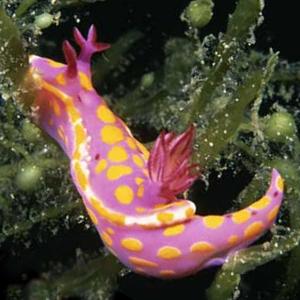
Dear Bill
As I mentioned in the last posting (about Chromodoris daphne), I have made a few dives a Shiprock [Port Hacking, Sydney] lately. On the one before last (30 Dec 200), I noted towards the end of the dive some kelp with several Ceratosoma amoena specimens high up (in the "fronds"). This was on kelp on a sandy bottom in the shallows, at the end of the dive. Of course, having taken a bunch of photos of C. daphne, I had no film left.
I went back on the high tide on 4 Jan 2001(about 4pm), and saved some film. Again I found three individuals doing the same thing, and got the photos attached. As I have learnt, nudis are carnivores, so they can't be eating, so I wonder if there is a simple or known explanation for this behaviour.
These photos are also interesting because the specimen I chose seems to have a deformity on the right rhinopore. Instead of being a single feeler, this one appears to have three arms, shaped like a trident.
Not sure if this is anything unusual, but thought you might be interested in these shots.
Best regards
Des
des@paroz.com
Paroz, D., 2001 (Jan 10) Ceratosoma amoena - unusual shape & behaviour. [Message in] Sea Slug Forum. Australian Museum, Sydney. Available from http://www.seaslugforum.net/find/3499Dear Des,
Always happy to see nice photos of nudibranchs doing interesting things. Firstly the trident shaped rhinophore is indeed unusual, and clearly a birth defect.
About the behaviour of crawling up the kelp. Some species seem to be 'wanderers' and others do not. C. amoena and Hypselodoris bennetti are two chromodorids that are often found crawling far from any obvious food. Around Sydney, in the shallow sublittoral, both these animals and another dorid, the bright red Rostanga arbutus can often be found crawling on kelp plants, especially as the tide is beginning to rise after low tide. These animals all feed on sponges which are not associated with kelp. All I can assume is that they have either ended up on the kelp by accident as they crawl around, or they have been dislodged during tidal movement and have ended up on the kelp by being 'filtered' out of the water as they ave floated past. I may be quite wrong but I have always assumed the presence on kelp is accidental.
If anyone has other ideas or observations I would like to hear of them.
Best wishes,
Bill Rudman
Re: Are these all Ceratosoma amoena?
August 12, 2000
From: Des Paroz
Hi Bill
Concerning my recent photos. All 3 were taken in New South Wales, Australia.
The top-most photo (long pink bodied nudi) was taken at Nelson Bay, Port Stephens, New South Wales in January.
The bottom-left shot (rounder pinkish body) was taken at Bare Island, Sydney, New South Wales.
The bottom-right picture (shorter, whiter body) was taken on one of the Islands off Wollongong, New South Wales.
The body colour variations I kind of expect, but 2 things picqued my interest
- The shape of the bottom left nudi being quite different to the other two (even though its colourations were closer to the top one).
- The colour of the rhinopores on the top-most photo not having that white streak.
So, that's why my first instinct was that they were all examples of C. amoena, but I am intrigued about the variations if they are.
Best regards
Des
des@paroz.com
Paroz, D., 2000 (Aug 12) Re: Are these all Ceratosoma amoena?. [Message in] Sea Slug Forum. Australian Museum, Sydney. Available from http://www.seaslugforum.net/find/2863Dear des,
Thanks for the information about the slides, and I am glad you are looking for variations and differences.
The shape is the easiest to answer. All nudibranchs can change shape, within limits. C. amoena when crawling, usually stands quite tall, with a lot of the foot visible. However, when at rest on a sponge or softer substrate, its 'posture' often collapses and it becomes a jelly-like shape, fitting in to the substrate. When it nestles into a crevice or hole its shape becomes even more irregular.
The range of colour variation within a species differs from species to species. While many species have very consistent parts to their colour pattern, such as thinophore and gill colouration, others such as C amoena show some variation. There is no easy rule of thumb. We can only be sure how variable a colour pattern can be when we study the anatomy of many animals. C. amoena shows quite a bit of colour variation but I can find no anatomical variation from New Zealand to Western Australia.
Rudman, W.B., 2000 (Aug 12). Comment on Re: Are these all Ceratosoma amoena? by Des Paroz. [Message in] Sea Slug Forum. Australian Museum, Sydney. Available from http://www.seaslugforum.net/find/2863Are these all Ceratosoma amoena?
August 10, 2000
From: Des Paroz

Hi Bill
Looking at some photos in my recently scanned batch of slides, and I have three different nudis that I would have thought at first were all Ceratosoma amoena.
However, if they are, there are distinct differences in the colourations, and even their shapes.
(Appologies for the third image, my scanning has washed it out a bit)
Would be interested in your comments on this, pretty common, species.
Best regards
Des
Sydney, Australia
www.divesite.paroz.com
des@paroz.com


Dear Des,
Some information on where and when these were photographed would be useful. If you have a look at the other photos at the top of the Ceratosoma amoena Page, and in the other messages on this page, you will find quite a variety of colour forms. Although they don't fit a perfect geographic sequence, specimens from New Zealand are usually much pinker without much in the way of red, and specimens from Western Australia have many small yellow spots. That's why geographic information on colour forms is useful as it helps us build up a picture of the variation found in the species whcih is found from New Zealand to southwestern Australia.
Best wishes,
Bill Rudman.
Ceratosoma amoena mating
July 12, 1999
From: Grey McNeil
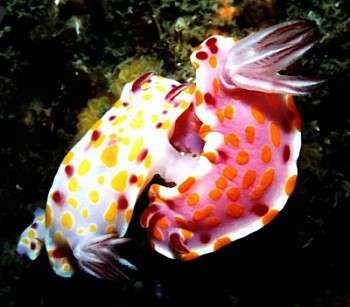
Dear Bill,
Could you identify this photo please. The details are:
FLY PT., NELSON BAY, Port Stephens, NSW, eastern Australia, 8m, February 1999, 3cm long.
Thanks,
Grey McNeil.
GREYMACIND@bigpond.com
McNeil, G., 1999 (Jul 12) Ceratosoma amoena mating. [Message in] Sea Slug Forum. Australian Museum, Sydney. Available from http://www.seaslugforum.net/find/999Dear Grey,
These two animals are a mating pair of Ceratosoma amoena, quite common in southern Australia and northern New Zealand. All sea slugs are hermaphrodite, which means they have a fully operational set of male and female reproductive organs. In chromodorids the penis and vagina are situated on the right side of the body behind the head. To mate, the two partners need to have their right sides together, as in your photo. The white 'tube' joining them is their joined reproductive organs.
Bill Rudman.
Rudman, W.B., 1999 (Jul 12). Comment on Ceratosoma amoena mating by Grey McNeil. [Message in] Sea Slug Forum. Australian Museum, Sydney. Available from http://www.seaslugforum.net/find/999Ceratosoma amoena from New Zealand
December 14, 1998
From: Ross Armstrong
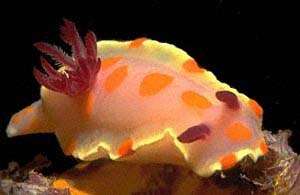
Bill,
Here is a photo of mine of Ceratosoma amoena from Whangarei Harbour, northeastern New Zealand. It is very common in the harbour, coast and Poor Knights Islands.
Ross Armstrong
ross@northpower.co.nz
Armstrong, R., 1998 (Dec 14) Ceratosoma amoena from New Zealand. [Message in] Sea Slug Forum. Australian Museum, Sydney. Available from http://www.seaslugforum.net/find/387Thanks for the photo Ross. As I describe above, the New Zealand form lacks the purple spots found in most Australian specimens, and the orange spots are much larger .. Bill Rudman
Rudman, W.B., 1998 (Dec 14). Comment on Ceratosoma amoena from New Zealand by Ross Armstrong. [Message in] Sea Slug Forum. Australian Museum, Sydney. Available from http://www.seaslugforum.net/find/387